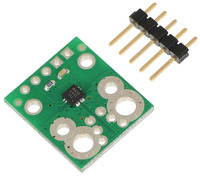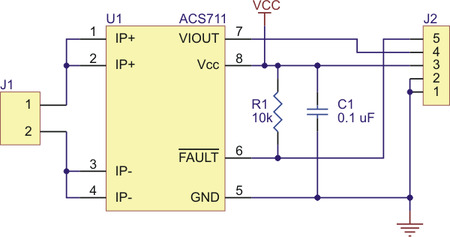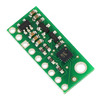

ACS711EX Current Sensor Carrier -31A to +31A
This board is a simple carrier of Allegro’s Âą31 A ACS711 Hall effect-based linear current sensor with overcurrent fault output, which offers a low-resistance (~0.6 mO) current path and electrical isolation up to 100 V. This version accepts a bidirectional current input with a magnitude up to 31 A and outputs a proportional analog voltage centered at Vcc/2 with a typical error of Âą4%. It operates from 3 V to 5.5 V, so it can interface directly to both 3.3 V and 5 V systems.
 |
 |
This current sensor is a carrier board or breakout board for Allegro’s ACS711KEXLT-31AB-T Hall effect-based linear current sensor with overcurrent fault output; we therefore recommend careful reading of the ACS711 datasheet (551k pdf) before using this product. This sensor has an operating voltage of 3 V to 5.5 V and an output sensitivity of 45 mV/A when Vcc is 3.3 V (or 68 mV/A when Vcc is 5 V). The following list details some of the sensor’s key features:
The pads are labeled on the bottom silkscreen, as shown in the picture to the right. The silkscreen also shows the direction that is interpreted as positive current flow via the +i arrow.
This 31 A current sensor is marked with a green X. We also sell a 15.5 A version that uses the same carrier PCB; you can distinguish the versions by reading the text on the IC or by looking at the color of the X on the bottom silkscreen.
This sensor is very similar to our original ACS711 -25 to +25 A Current Sensor Carrier, but uses a smaller “EX” package that has a larger optimized sensing range and reduced internal resistance. The board size, pinout, and hole locations are all unchanged, so it can generally be used as a drop-in replacement for our ACS711 carriers with “LC” packages.
The sensor requires a supply voltage of 3 V to 5.5 V to be connected across the Vcc and GND pads, which are labeled on the bottom silkscreen. The sensor outputs an analog voltage that is linearly proportional to the input current. The quiescent output voltage is Vcc/2 and changes by 45 mV per amp of input current (when Vcc = 3.3 V), with positive current increasing the output voltage and negative current decreasing the output voltage. The relationship between the instantaneous input current, i, and sensor output voltage, VOUT, can be represented by the following equations:
 |
The FAULT pin is normally high and latches low when the current exceeds Âą31 A. Once the FAULT pin is latched low, the only way to reset it is by toggling power on the Vcc pin. In our tests, this module was able to handle 31 A of continuous current without exceeding 100°C, with no cooling beyond the heat dissipation of the PCB.
|
|
The input current can be connected to the board in a variety of ways. Holes with 0.1", 3.5 mm, and 5 mm spacing are available as shown in the diagram above for connecting male header pins or terminal blocks. For high-current applications, you can solder wires directly to the through-holes that best match your wires, or you can use solderless ring terminal connectors, as shown in the picture above. The large through-holes are big enough for #6 screws.
Warning: This product is intended for use below 30 V. Working with higher voltages can be extremely dangerous and should only be attempted by qualified individuals with appropriate equipment and protective gear.
The board has two mounting holes on the logic side of the board. These mounting holes are 0.5" apart and are designed for #2 screws.
This board ships assembled with all surface mount components, and a 5×1 strip of 0.1" header pins is included but not soldered in, as shown in the picture below.
 |
| ACS711EX current sensor carrier with included 5 × 1 0.1" header pins. |
|---|
 |
| ACS711 current sensor carrier schematic diagram. |
|---|
 |
ACS711EX Current Sensor Carrier -15.5A to +15.5A |
 |
ACS709 Current Sensor Carrier -75A to +75A |
 |
LPS331AP Pressure/Altitude Sensor Carrier with Voltage Regulator |
Producent BTC Korporacja sp. z o. o. Lwowska 5 05-120 Legionowo Polska sprzedaz@kamami.pl 22 767 36 20
Osoba odpowiedzialna BTC Korporacja sp. z o. o. Lwowska 5 05-120 Legionowo Polska sprzedaz@kamami.pl 22 767 36 20
Kompaktowy czujnik prądu oparty na technologii Halla, umożliwiający dokładny pomiar prądu DC i AC w zakresie ±30 A z galwaniczną izolacją. Ma analogowe wyjście VOUT z dużą czułością i pasmem 150 kHz, co pozwala na szybkie i precyzyjne odczyty w dynamicznych układach. Moduł pracuje w szerokim zakresie temperatur od -40°C do 125°C, a niska rezystancja ścieżki prądowej (~1,6 mΩ) minimalizuje straty energii. Dzięki niewielkim wymiarom i elastycznym opcjom montażu jest idealny do zastosowań w prototypach, systemach przemysłowych i projektach o ograniczonej przestrzeni. Pololu 5451
Brak towaru
Moduł z czujnikiem prądu ACS724LLCTR-10AB o zakresie pomiarowym prądu od -10 do +10 A. Komunikuje się przez interfejs analogowy. Pololu 4043
Moduł z analogowym czujnikiem prądu. Umożliwia pomiar prądu przemiennego i stałego o natężeniu do 50 A. DFRobot SEN0098
Brak towaru
Moduł czujnika natężania prądu wykonujący pomiary w zakresie -40 ~ 40 A, z niską rezystancją 0,7 mΩ i izolacją elektryczną do 3 kV. Pololu 4033
Pololu 5242 z układem ACS71240KEXBLT-050B3 to kompaktowy moduł czujnika prądu do precyzyjnych aplikacji pomiarowych w zakresie ±50 A. Dzięki izolacji galwanicznej, szybkiej reakcji na zmiany prądu i możliwości detekcji zwarć, znajduje zastosowanie w systemach zasilania, elektronice motoryzacyjnej, przemysłowej i projektach embedded. Idealny do pomiaru prądów w obwodach DC i AC z zachowaniem bezpieczeństwa i precyzji.
Moduł czujnika prądu ACS72981, który wykorzystuje efekt Halla do precyzyjnego i bezpiecznego pomiaru prądu AC oraz DC, zapewniając elektryczną izolację ścieżki prądowej. Dzięki szerokopasmowemu wyjściu analogowemu (do 250 kHz) i niskiej rezystancji przewodzącej (0,2 mΩ) minimalizuje straty energii i oferuje szybki czas reakcji poniżej 2 µs. Pololu 5273
Moduł umożliwiający precyzyjny, izolowany galwanicznie pomiar prądu w zakresie ±30 A oraz napięcia do 480 VRMS, zapewniając odczyty wartości RMS, chwilowych i mocy czynnej, biernej i pozornej. Wyposażony w interfejs I²C, złącza JST SH 4-pin oraz piny 2,54 mm, pozwala na łatwą integrację z systemami Qwiic, STEMMA QT oraz standardowymi mikrokontrolerami, a konfiguracja przechowywana w EEPROM umożliwia definiowanie adresu i progów przeciążeniowych. Czujnik oferuje trzy zakresy pomiaru napięcia (120 V - domyślnie, 240 V, 480 V RMS) oraz możliwość wykrywania przepięć, a wbudowane zabezpieczenia i niskie rezystancje przewodzenia zapewniają bezpieczeństwo i dokładność pomiarów. Pololu 5410
Brak towaru
Moduł czujnika prądu ACS72981, który wykorzystuje efekt Halla do precyzyjnego i bezpiecznego pomiaru prądu AC oraz DC, zapewniając elektryczną izolację ścieżki prądowej. Dzięki szerokopasmowemu wyjściu analogowemu (do 250 kHz) i niskiej rezystancji przewodzącej (0,2 mΩ) minimalizuje straty energii i oferuje szybki czas reakcji poniżej 2 µs. Pololu 5256
Moduł czujnika prądu ACS72981, który wykorzystuje efekt Halla do precyzyjnego i bezpiecznego pomiaru prądu AC oraz DC, zapewniając elektryczną izolację ścieżki prądowej. Dzięki szerokopasmowemu wyjściu analogowemu (do 250 kHz) i niskiej rezystancji przewodzącej (0,2 mΩ) minimalizuje straty energii i oferuje szybki czas reakcji poniżej 2 µs. Pololu 5259
ACS711EX Current Sensor Carrier -15.5A to +15.5A
Kompaktowy czujnik prądu oparty na technologii Halla, umożliwiający dokładny pomiar prądu DC i AC w zakresie ±10 A z galwaniczną izolacją. Ma analogowe wyjście VOUT z dużą czułością i pasmem 150 kHz, co pozwala na szybkie i precyzyjne odczyty w dynamicznych układach. Moduł pracuje w szerokim zakresie temperatur od -40°C do 125°C, a niska rezystancja ścieżki prądowej minimalizuje straty energii. Dzięki niewielkim wymiarom i elastycznym opcjom montażu jest idealny do zastosowań w prototypach, systemach przemysłowych i projektach o ograniczonej przestrzeni. Pololu 5456
Kompaktowy czujnik prądu oparty na technologii Halla, umożliwiający dokładny pomiar prądu DC i AC w zakresie ±10 A z galwaniczną izolacją. Ma analogowe wyjście VOUT z czułością 132 mV/A i pasmem 150 kHz, co pozwala na szybkie i precyzyjne odczyty w dynamicznych układach. Moduł pracuje w szerokim zakresie temperatur od -40°C do 125°C, a niska rezystancja ścieżki prądowej (~1,6 mΩ) minimalizuje straty energii. Dzięki niewielkim wymiarom i elastycznym opcjom montażu jest idealny do zastosowań w prototypach, systemach przemysłowych i projektach o ograniczonej przestrzeni. Pololu 5440
Kompaktowy czujnik prądu oparty na technologii TMR, umożliwiający precyzyjne pomiary do 30 A przy minimalnych stratach energii. Dzięki szerokiemu pasmu 1 MHz, galwanicznej izolacji oraz odporności na zakłócenia, doskonale sprawdza się w aplikacjach wymagających szybkiej reakcji i wysokiej dokładności. Pololu 5317
Czujnik pozwala mierzyć natężenie prądu płynącego w przewodzie bez jego rozcinania. Pomiar odbywa się w sposób indukcyjny na pojedynczym przewodzie. Wyjściem czujnika jest natężenie prądu w zakresie od 0 do 50mA. SCT-013-000
Moduł z czujnikiem prądu ACS724LLCTR-2P5AB o zakresie pomiarowym prądu stałego i przemiennego od -2,5 do +2,5 A. Komunikuje się przez interfejs analogowy. Pololu 4040
Moduł z czujnikiem prądu ACS723 o zakresie pomiarowym prądu stałego i przemiennego ±5 A. Komunikuje się przez interfejs analogowy. SparkFun SEN-13679

ACS711EX Current Sensor Carrier -31A to +31A
